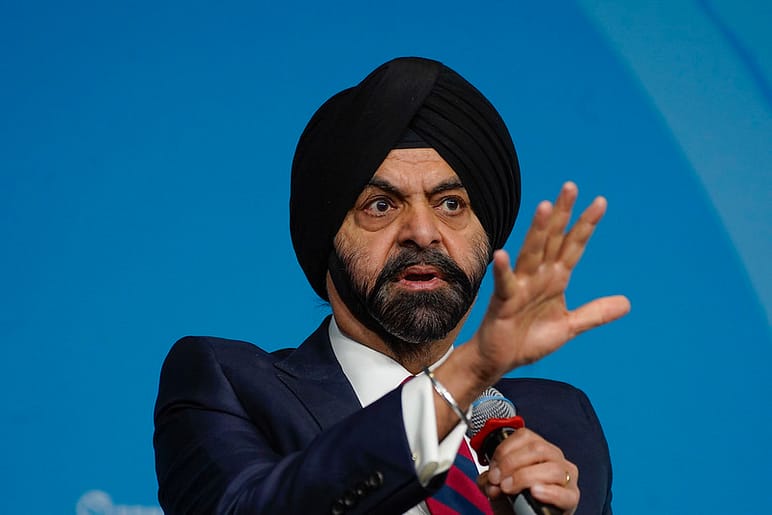Alessandro Ramazzotti is a researcher at the International Accountability Project, an international advocacy organization
Animal agriculture is one of the leading drivers of the climate crisis. According to a recent World Bank report, food and agriculture generate almost a third of global greenhouse gas emissions, of which meat and dairy account for nearly 60 percent.
Separate analysis shows that cattle ranching accounts for around 70 percent of the current deforestation of the Amazon. Recognising the significant problems that animal-based foods are causing, the World Bank’s cafeteria stopped serving meat earlier this year.
At the IMF-World Bank annual meetings last month, Bank President Ajay Banga went much further, by announcing plans to create “a comprehensive ecosystem for agribusiness”, with a pledge to double its funding for agriculture to $9 billion a year by 2030. Banga told attendees that finance should be used to advance climate-smart agriculture, which would “grow productivity” while reducing associated emissions.
However, while the World Bank appears to be saying many of the right things about sustainable farming, new research we carried out on behalf of Stop Financing Factory Farming (S3F) – a coalition of more than 25 human rights, environmental and animal protection organizations – shows that the World Bank and other multilateral development banks are failing spectacularly to put their money behind sustainable solutions.
‘Worst Offender’
We found that 16 leading international finance institutions together invested $3.33 billion in animal agriculture in 2023. Over two thirds (68 percent or $2.27 billion) was channeled to industrial agriculture or factory farming – projects that support concentrated or intensive animal operations or supply chain activities. And just two percent ($77 million) went towards non-industrial animal farming projects, which invest in small-scale agriculture and more sustainable practices.
Worryingly, we were unable to categorize the remaining 29 percent ($979 million) because of a lack of transparency from the banks about what they’re funding.
The World Bank Group was the worst offender – investing $747 million in factory farming in 2023. Two-thirds ($501m) of that came from its private sector arm, the International Finance Corporation (IFC). The next largest investors were the European Investment Bank ($427m) and the African Development Bank ($410m).
In his speech at the World Bank annual meetings, President Banga promised to bring all parts of the Bank together “to work as one unit” – to dramatically scale up agricultural climate finance, and to specifically support smallholder farmers and farmer organizations. Yet this is not what we’re seeing. Some of the investments that the IFC made were simply outrageous for an organization that has committed to align its investments with the Paris Agreement and the Global Biodiversity Framework.
For example, last year IFC provided a $47 million loan to a Chinese company for four multi-story pig farms. These “hog hotels”, which can be up to 13 stories high, cram pigs into appalling conditions and generate high levels of emissions, waste and environmental damage.
The IFC has also lent money to Pronaca, Ecuador’s largest pork and poultry producer, to build new factory farms in Santo Domingo de los Tsáchilas, an area of Ecuador that is home to the Tsáchila indigenous community and large swathes of tropical forest. The pig farms in the area generate an estimated two million kilograms of toxic waste every day – resulting in contaminated rivers, killing off fish which local people rely on for food and jobs, and harming local tourism.
More recently, the IFC proposed a $60 million investment to expand its industrial-scale cattle farming operations in Mongolia. After local and global civil society groups raised concerns, the IFC postponed its board discussion date twice, showing their vulnerability to the arguments raised against the project.
Urgent Review Needed
The role of multilateral development banks – including the World Bank and its subsidiaries – should be to help spur the transition towards more sustainable diets and forms of food production, rather than replicating and expanding the broken systems that are wrecking our planet. Traditional food production systems and local expertise should be leveraged to improve food security among the most vulnerable populations, rather than expanding harmful global value chains that enrich a few corporations based in Europe and North America.
At a global level, we need to increase the production and consumption of plant-rich foods, which are better for the environment. Some banks are already supporting their uptake – for example, the European Investment Bank is investing in plant-based meat alternatives.
Animal products also remain an important part of many people’s diets – particularly in low income countries, where parts of the population might struggle to get the nutrients they need from other sources of food. Therefore banks should invest in animal agriculture projects, but only when they are sustainable – following agroecological principles such as promoting species diversity, using nature’s resources efficiently, and recycling waste products.
For example, banks should support livestock farms that recycle human food waste by feeding it to pigs and chickens; or silvo-pastoral agroforestry, where trees are planted at wide spacings or existing woodland thinned to allow the undergrowth to flourish for livestock to feed on – which is good for biodiversity, animal welfare and income diversification.
As the World Bank prepares to rapidly increase its agricultural spending, it’s vital that it – and all other multilateral development banks – urgently review their lending portfolios and rule out any further factory farm investments, which are totally out of step with the promises they’ve made to tackle climate change. Doing this would not only be good for the climate, but also bring a whole host of other economic and social benefits, including improving diets, creating jobs and supporting biodiversity.

